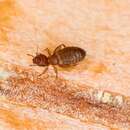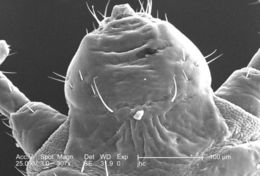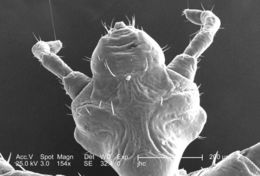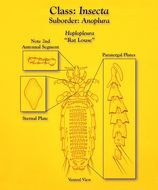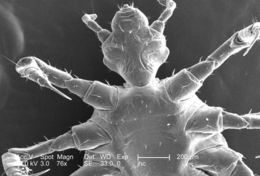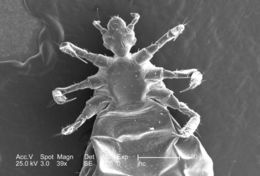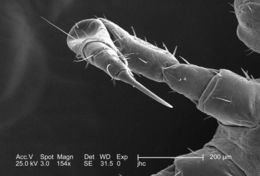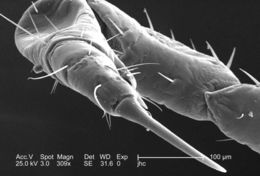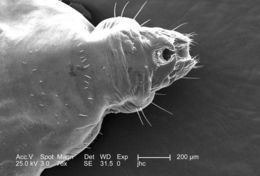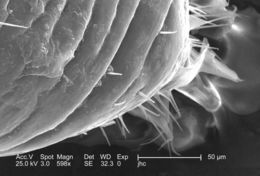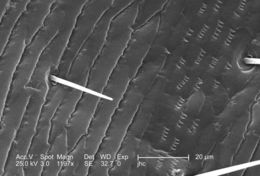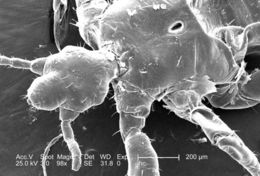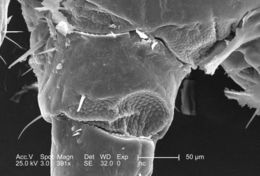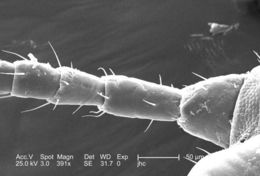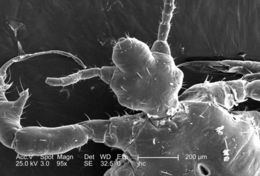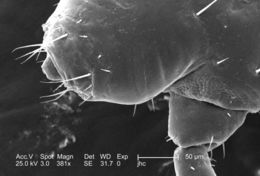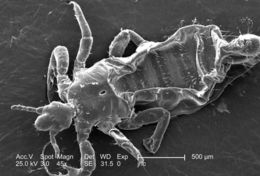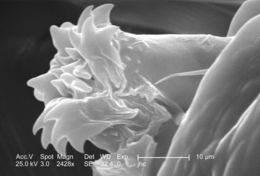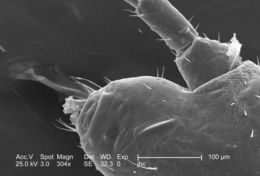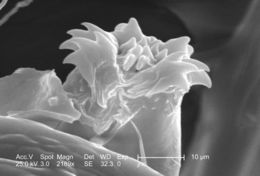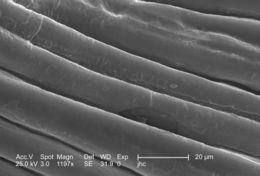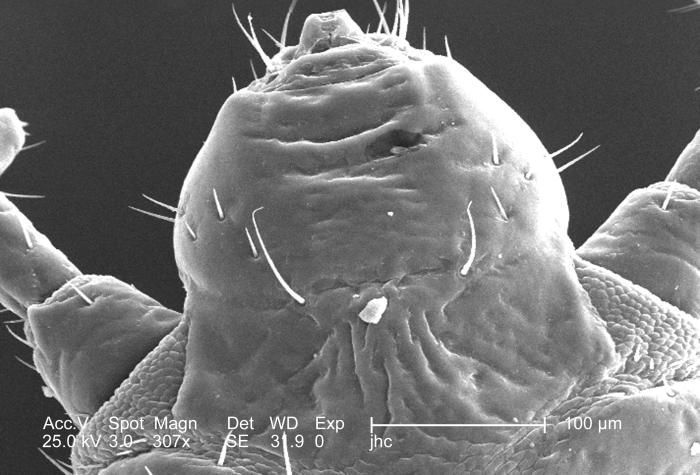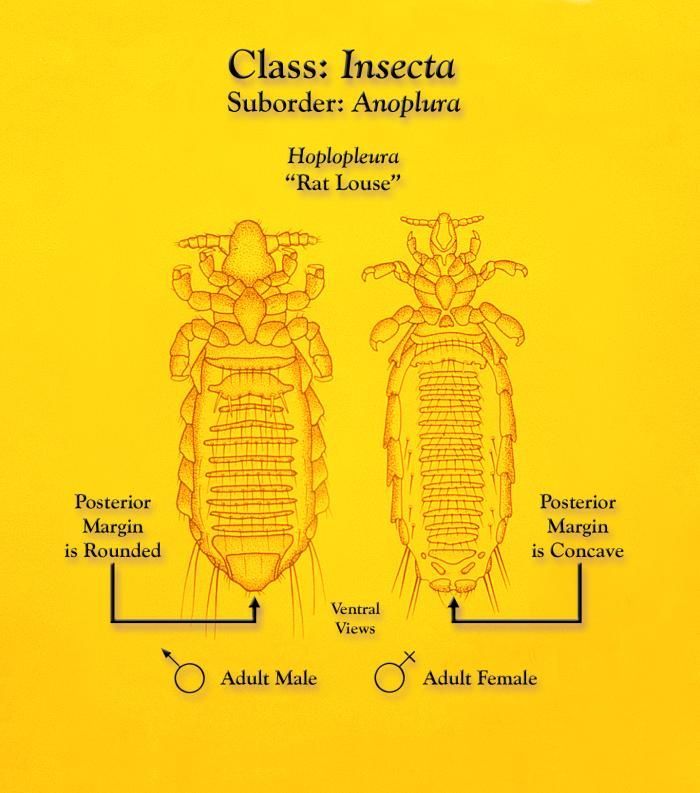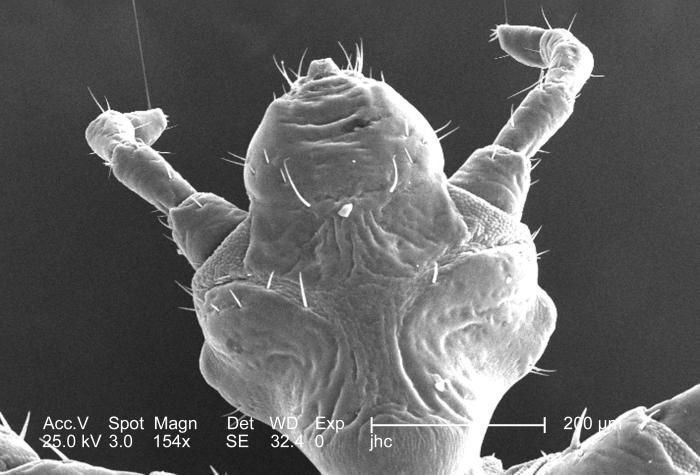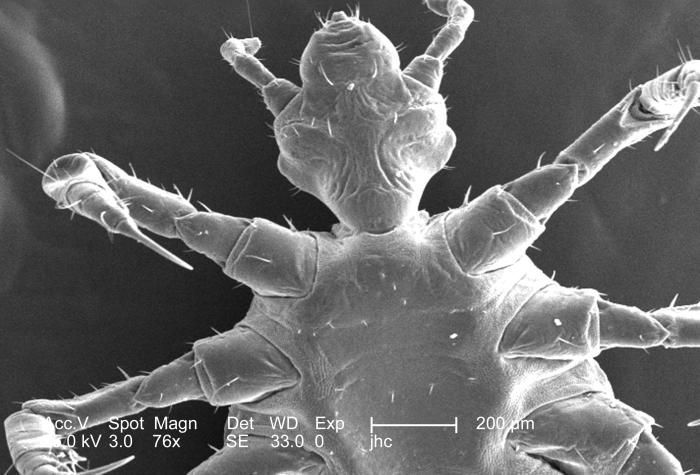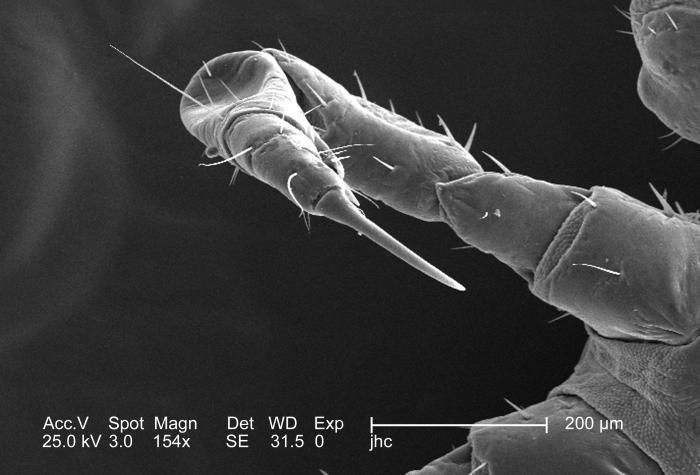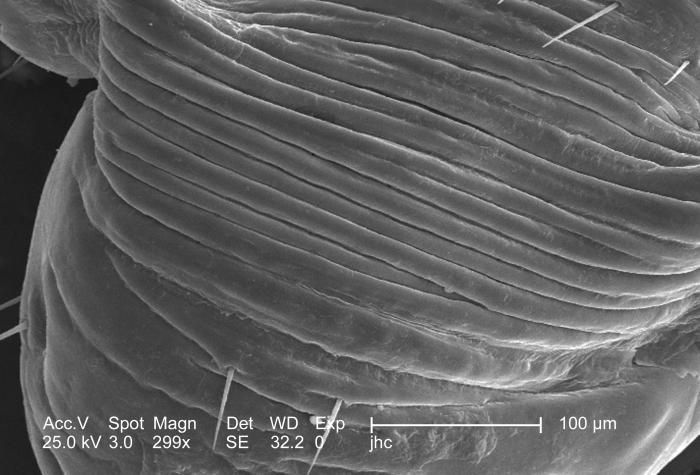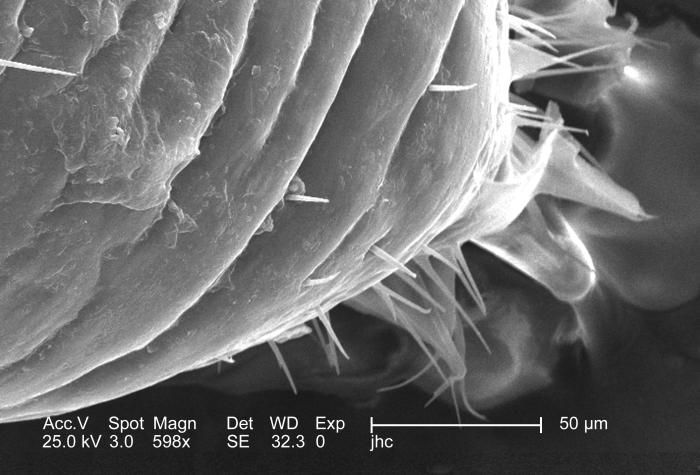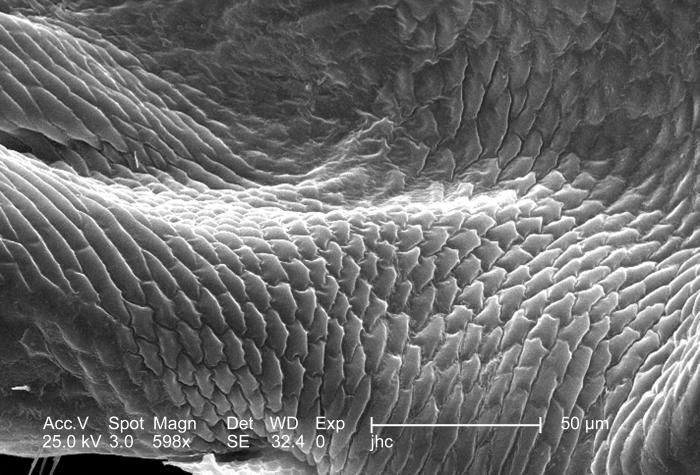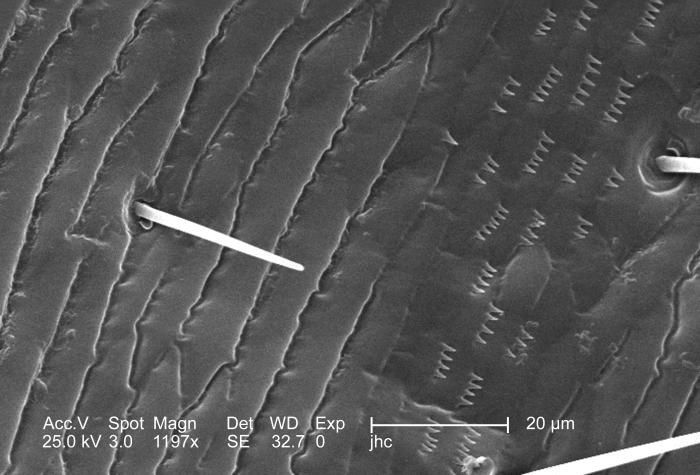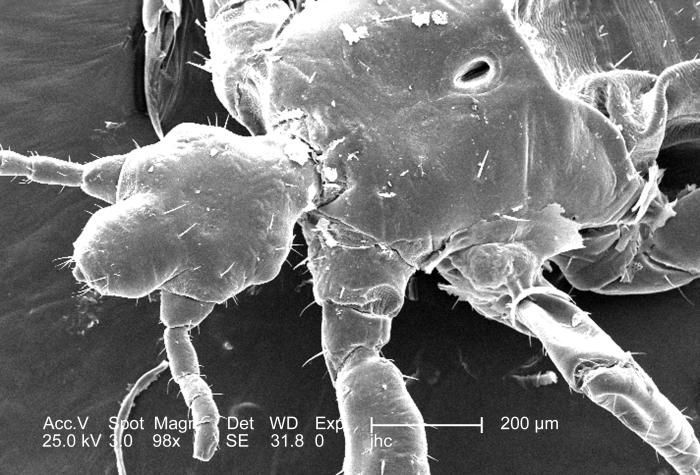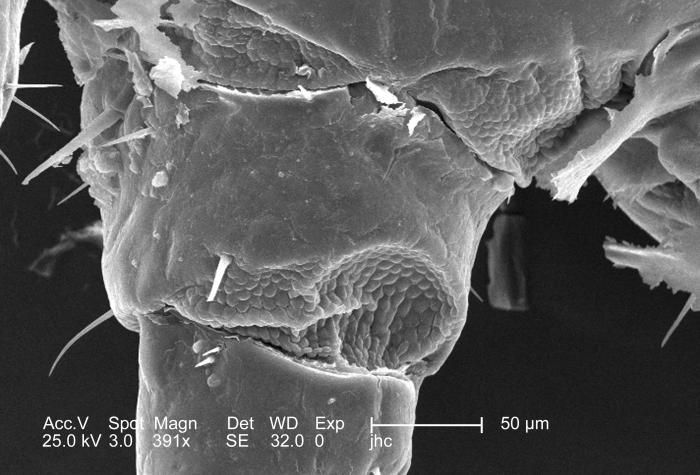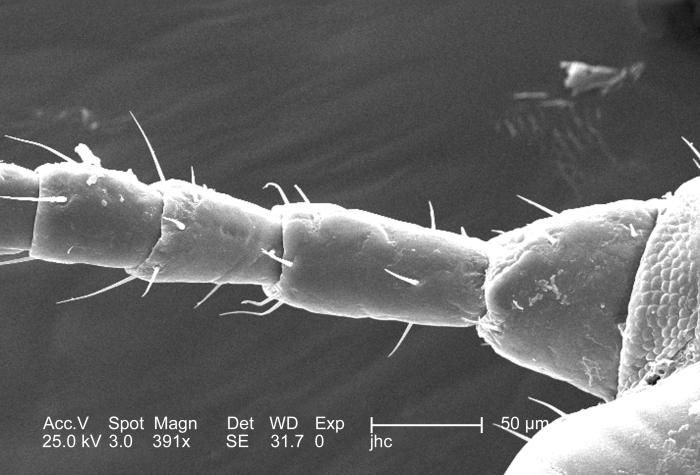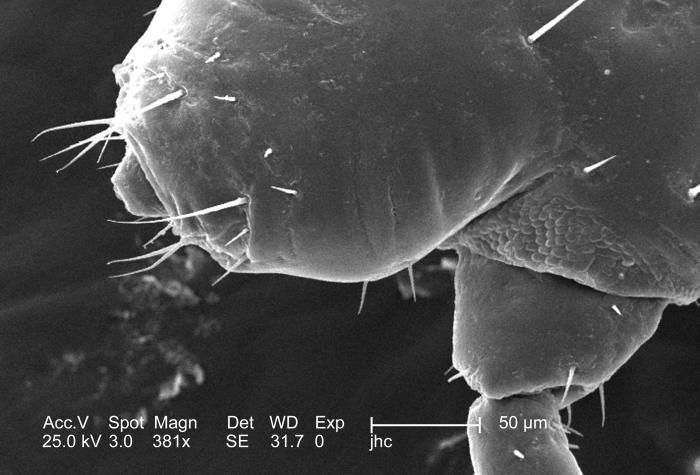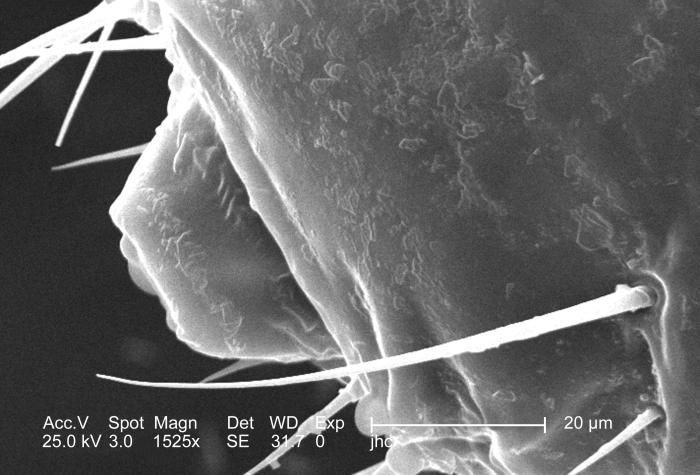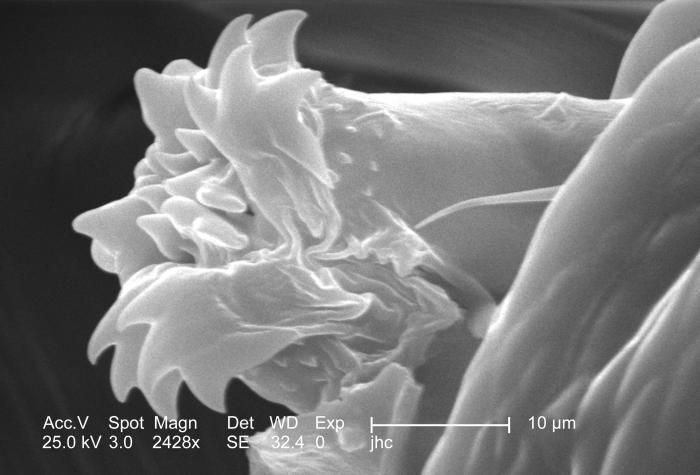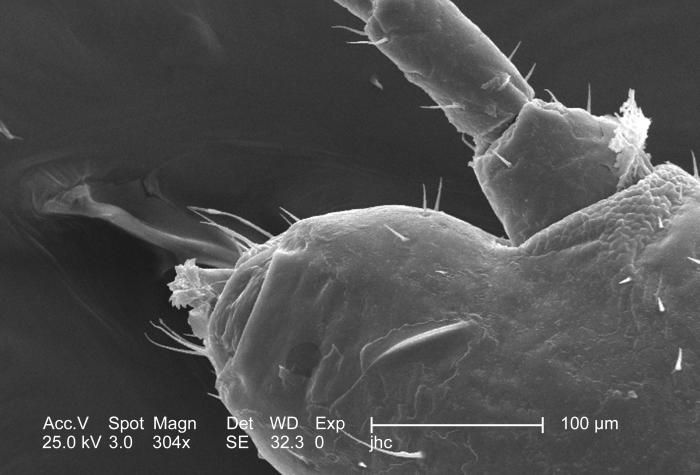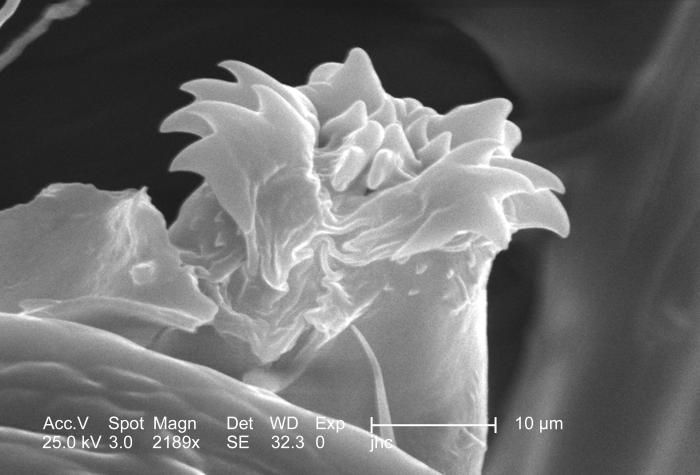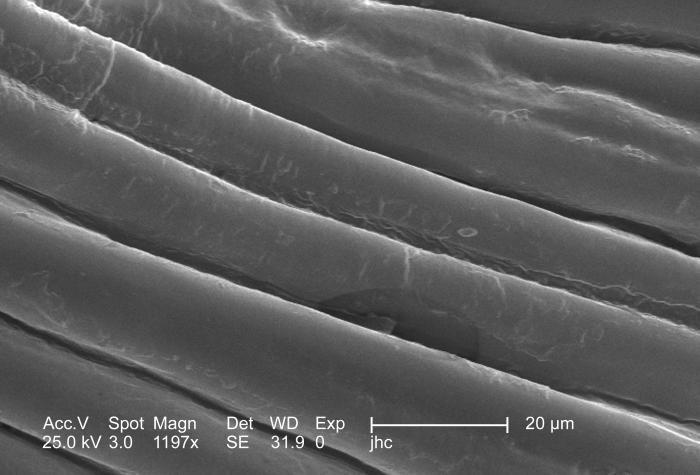-
This was one of five scanning electron micrographic (SEM) images (PHIL# 9243 9247), successively magnified at higher and higher values, which focused on the head region of a female body louse, Pediculus humanus var. corporis from a ventral perspective. At a moderate magnification of 307x, this SEM revealed some of the insects exoskeletal morphology exhibited by the cephalic region. Note the two partially visible, bilaterally situated antennae composed of three main segments: visible here was the most proximal scape and the pedicle, and not in the field of view, the multi-segmented flagellum. The antennae, and the insects body sport sensorial hairs known as "setae, both of which provided the organism with a "picture of its environment, by taking readings in thermal, chemical, and mechanical changes encountered in its immediate surroundings. Its cone-shaped mouth is located at the very top of the image.Created: 2006
-
This illustration depicts a male (Lt) and female (Rt) rat louse of the genus Hoplopleura from a ventral view.Created: 1975
-
This was one of five scanning electron micrographic (SEM) images (PHIL# 9243 9247), successively magnified at higher and higher values, which focused on the head region of a female body louse, Pediculus humanus var. corporis from a ventral perspective. At a relatively low magnification of 154x, this SEM revealed some of the insects exoskeletal morphology exhibited by the cephalic region. Note the two bilaterally situated antennae composed of three main segments: the most proximal scape, a pedicle, and the multi-segmented flagellum. The antennae, and the insects body sport sensorial hairs known as "setae, both of which provided the organism with a "picture of its environment, by taking readings in thermal, chemical, and mechanical changes encountered in its immediate surroundings.Created: 2006
-
This illustration depicts a rat louse, which is a member of the genus, Hoplopleura from a ventral view, as well as three insets that highlight three distinct morphologic features unique to this genus.Created: 1975
-
This was one of five scanning electron micrographic (SEM) images (PHIL# 9243 9247), successively magnified at higher and higher values, which focused on the head region of a female body louse, Pediculus humanus var. corporis from a ventral perspective. At a relatively low magnification, this SEM revealed some of the insects exoskeletal morphology exhibited by its cephalic, or head region, thoracic, and proximal abdominal regions. Of interest is the jointed configuration of its six extremities, from which it derived its classification in the phylum of Athropoda, i.e., Arthro from "joint, and poda from "leg"). Also note the sensorial hairs known as setae, which really arent hairs at all, but chitinous exoskeletal extensions, unlike mammalian hairs, which are made up of keratin, and make mammals unique in this regard.Created: 2006
-
This was one of five scanning electron micrographic (SEM) images (PHIL# 9243 9247), successively magnified at higher and higher values, which focused on the head region of a female body louse, Pediculus humanus var. corporis from a ventral perspective. At a relatively low magnification, this SEM revealed some of the insects exoskeletal morphology exhibited by its cephalic, or head region, thoracic, and proximal abdominal regions. Of interest is the jointed configuration of its six extremities, from which it derived its classification in the phylum of Athropoda, i.e., Arthro from "joint, and poda from "leg").Created: 2006
-
At half the magnification of PHIL# 9241, this 2006 scanning electron micrograph (SEM) depicted a dorsal view of the right flexed foreleg of a female body louse, Pediculus humanus var. corporis, in its entirty. What is visible includes the most distal segment, known as the pretarsus, followed by the more proximal tarsus, then the tibia, femur, and trochanter, and finally the most proximal segment, the coxa. In the case of the louse, the leg segments are very stout, and end in claws, which it used to firmly grasp clothing, or a hosts hair shafts. Note how the exoskeletal covering appears to possess an almost fabric-like appearance to the chitinous exoskeleton, which acts to add flexibility at the coxa-trochanteric joint.Created: 2006
-
At a moderate magnification of 309x, this 2006 scanning electron micrograph (SEM) depicted an enlarged dorsal view of the right flexed foreleg of a female body louse, Pediculus humanus var. corporis. The entire leg is not quite visible, but what is visible includes the most distal segment, known as the pretarsus, followed by the more proximal tarsus, then the tibia, femur, and trochanter. The final segment, of the six segments from which each leg is composed, the coxa, is visible under reduced magnification, in PHIL# 9242. In the case of the louse, the leg segments are very stout, and end in claws, which it used to firmly grasp clothing, or a hosts hair shafts.Created: 2006
-
This 2006 scanning electron micrograph (SEM), under a low magnification of only 76x, revealed the distal tip of the abdominal region of a female body louse, Pediculus humanus var. corporis from a dorsal perspective. Some of the morphologic characteristics seen in this image include the two gonopodia, which are located dorsal to the larger two setae-bearing claspers. It is into this notch that the male would insert the aedeagus, or penis during the process of copulation. This notch, identifying the louse as a female is observable to the naked eye, whereas, in the male louse, the distal abdomen is rounded, and not concave.Created: 2006
-
At a low magnification of 299x, this 2006 scanning electron micrograph (SEM) depicted an enlarged view of the chitinous, exoskeletal surface of a male louse, Pediculus humanus var. corporis. In this particular view, the exoskeleton seems to be configured in accordion-like convolutions, which is visible with the naked eye on the insects abdomen. Chitin is a molecule made up of bound units of acetylglucosamine, which is joined in such a way as to allow for increased points at which hydrogen bonding can occur. In this way chitin provides increased strength, and durability as an exoskeletal foundation. Note the sparse amount of setae, or sensorial hairs in this area of the abdominal surface.Created: 2006
-
Magnified 598x, this 2006 scanning electron micrograph (SEM) depicted an enlarged view of the chitinous, exoskeletal surface of a male louse, Pediculus humanus var. corporis. In this particular view, the exoskeleton seems to be configured in accordion-like convolutions, which is visible with the naked eye on the insects abdomen. Chitin is a molecule made up of bound units of acetylglucosamine, which is joined in such a way as to allow for increased points at which hydrogen bonding can occur. In this way chitin provides increased strength, and durability as an exoskeletal foundation. Note the sparse amount of setae, or sensorial hairs in this area of the abdominal surface.Created: 2006
-
Magnified 598x, this 2006 scanning electron micrograph (SEM) depicted an enlarged view of the chitinous, exoskeletal surface of a male louse, Pediculus humanus var. corporis. In this particular view, the exoskeleton seems to be composed of interlocking plates, which is not far from the case. In this region, between two exoskeletal segments, in order to provide flexibility to this patent joint, the chitinous components were arranged in a plate-like manner, attached to one another with thin, though strong layers of exoskeletal chitin. Chitin is a molecule made up of bound units of acetylglucosamine, which is joined in such a way as to allow for increased points at which hydrogen bonding can occur. In this way chitin provides increased strength, and durability as an exoskeletal foundation.Created: 2006
-
Magnified 1197x, this 2006 scanning electron micrograph (SEM) depicted an enlarged view of the chitinous, exoskeletal surface of a male louse, Pediculus humanus var. corporis. In this particular view, the exoskeletal adornments are few, consisting of small, spike-like structures and a number of setae, or sensorial hairs. Quite often the shape and size of these skeletal adnexae are quite complex, with forms following functions, which are just as varied. The exoskeleton is composed of chitin, a molecule made up of bound units of acetylglucosamine, which is joined in such a way as to allow for increased points at which hydrogen bonding can occur. In this way chitin provides increased strength, and durability as an exoskeletal foundation.Created: 2006
-
At a low magnification of 98x, this 2006 scanning electron micrograph (SEM) depicted a dorsal view of the head and left thorax of a male body louse, Pediculus humanus var. corporis. The entire left foreleg, or middle leg are not visible, but what is visible, includes each leg's coxa, trochanter, and femur, or the first, second, and third leg segments respectively. For a complete dorsal view of the louses leg, see PHIL# 9228. The leg is composed of six segments: coxa, trochanter, femur, tibia, tarsus, and pretarsus or claw. In the case of the louse, the leg segments are very stout, and end in claws, which it used to firmly grasp clothing, or a hosts hair shafts. Note how the exoskeletal covering appears to possess an added flexibility at the coxa-trochanteric joint.Created: 2006
-
At a moderate magnification of 391x, this 2006 scanning electron micrograph (SEM) depicted an enlarged dorsal view at the proximal end of the left foreleg of a male body louse, Pediculus humanus var. corporis. The entire leg is not visible, but what is visible, includes the coxa and the trochanter, or the first and second leg segments respectively. For a complete dorsal view of the louses leg, see PHIL# 9228. The leg is composed of six segments: coxa, trochanter, femur, tibia, tarsus, and pretarsus or claw. In the case of the louse, the leg segments are very stout, and end in claws, which it used to firmly grasp clothing, or a hosts hair shafts. Note how the exoskeletal covering appears to possess an added flexibility at the coxa-trochanteric joint.Created: 2006
-
At a moderate magnification of 391x, this 2006 scanning electron micrograph (SEM) depicted an enlarged dorsal view at the proximal end of the right antenna of a male body louse, Pediculus humanus var. corporis. The antennae are composed of three main regions: scape, pedicle, and flagellum. The scape attaches the sensory organ to the head region, and the pedicle joins the distal, jointed flagellum to the scape. The bilaterally situated antennae are not the only structures in the insect's repertoire of sensorial apparatuses that provide it with information of changes in its environment. In fact, the hairs dispersed over its exoskeletal surface, are also used as integral sensorial instruments, and are known as "setae, evident on this antenna in this SEM.Created: 2006
-
At a low magnification of 95x, this 2006 scanning electron micrograph (SEM) depicted an enlarged dorsal view of the cephalic, or head region of a male louse, Pediculus humanus var. corporis. In this particular view, the louses haustellum is withdrawn, or internalized inside the mouth region of the insects cephalic region. The haustellum is a tube-like structure, fromed from what is believed to be a modification of the labium, but is armed with teeth, which act to grab, and hold on to the skin surface of its host while obtaining its blood meal. The insect pierces the hosts skin with its sharply-pointed set of three stylets, which together for what is termed the fascicle. The pair of jointed bilateral antennae and the insects body sport sensorial hairs known as "setae, both of which provided the organism with a "picture of its environment, by taking readings in thermal, chemical, and mechanical changes encountered in its immediate surroundings.Created: 2006
-
At a moderate magnification of 381x, this 2006 scanning electron micrograph (SEM) depicted an enlarged dorsal view of the mouth region of a male louse, Pediculus humanus var. corporis. In this particular view, the louses haustellum is withdrawn, or internalized inside the mouth region of the insects cephalic region. The haustellum is a tube-like structure, fromed from what is believed to be a modification of the labium, but is armed with teeth, which act to grab, and hold on to the skin surface of its host while obtaining its blood meal. The insect pierces the hosts skin with its sharply-pointed set of three stylets, which together for what is termed the fascicle. Note PHIL# 9214, 9216, in which case a lose is in its feeding mode on the skin surface of its host.Created: 2006
-
Magnified 1525x, this 2006 scanning electron micrograph (SEM) depicted an enlarged dorsal view of the mouth region of a male louse, Pediculus humanus var. corporis. In this particular view, the louses haustellum is withdrawn, or internalized inside the mouth region of the insects cephalic region. The haustellum is a tube-like structure, fromed from what is believed to be a modification of the labium, but is armed with teeth, which act to grab, and hold on to the skin surface of its host while obtaining its blood meal. The insect pierces the hosts skin with its sharply-pointed set of three stylets, which together for what is termed the fascicle. Note PHIL# 9214, 9216, in which case a lose is in its feeding mode on the skin surface of its host.Created: 2006
-
Under a relatively low magnification of 45x, this 2006 scanning electron micrograph (SEM) depicted a dorsal, or superior view, of a male louse, Pediculus humanus var. corporis. The head, or cephalic region is at the left, from which its two antennae were extended. The head was attached to the thoracic region, which gave rise to its three pairs of jointed legs. While the abdominal region, towards the far right, is the region in which was housed the stomach, and intestines. The jointed nature of its extremities, designates this organism as a member of the phylum Arthropoda, and the fact that there are three pairs of legs, the louse is, thereby, placed into the class, Insecta. Note the small, hair-like structures adorning the exoskeletal surface of this insect. These are known as setae, and are not hairs at all, but extensions of the chitinous exoskeletal surface, which provide the organism with sensorial data about its surroundings.Created: 2006
-
Under a high magnification of 2428x, this 2006 scanning electron micrograph (SEM) depicted an enlarged inferior view of the mouthparts found on the cephalic, or head region of a male body louse, Pediculus humanus var. corporis. The floral-like structure in this field of view represents the labial funnel, or haustellum, which is a tube-like structure, formed from what is believed to be a modification of the labium, but is armed with teeth, which act to grab, and hold on to the skin surface of its host while obtaining its blood meal. The insect pierces the hosts skin with its sharply-pointed set of three stylets, and together, form what is termed the fascicle, which is hidden from view in this image. Note PHIL# 9214, 9216, in which case a louse is in its feeding mode on the skin surface of its host.Created: 2006
-
Under a moderately low magnification of 304x, this 2006 scanning electron micrograph (SEM) depicted an enlarged inferior view of the mouthparts found on the cephalic, or head region of a male body louse, Pediculus humanus var. corporis. The floral-like structure in this field of view represents the labial funnel, or haustellum, which is a tube-like structure, formed from what is believed to be a modification of the labium, but is armed with teeth, which act to grab, and hold on to the skin surface of its host while obtaining its blood meal. The insect pierces the hosts skin with its sharply-pointed set of three stylets, and together, form what is termed the fascicle, which is hidden from view in this image. Note PHIL# 9214, 9216, in which case a louse is in its feeding mode on the skin surface of its host. Also note the scape and pedicle, or the respective proximal segments of the insect's left antenna in this view as well.Created: 2006
-
Under a high magnification of 2189x, this 2006 scanning electron micrograph (SEM) depicted an enlarged inferior-oblique view of the mouthparts found on the cephalic, or head region of a male body louse, Pediculus humanus var. corporis. The floral-like structure in this field of view represents the labial funnel, or haustellum, which is a tube-like structure, formed from what is believed to be a modification of the labium, but is armed with teeth, which act to grab, and hold on to the skin surface of its host while obtaining its blood meal. The insect pierces the hosts skin with its sharply-pointed set of three stylets, and together, form what is termed the fascicle, which is hidden from view in this image. Note PHIL# 9214, 9216, in which case a louse is in its feeding mode on the skin surface of its host.Created: 2006
-
Under a moderately high magnification of 1197x, this 2006 scanning electron micrograph (SEM) depicted an enlarged view of the chitinous, exoskeletal surface of a male louse, Pediculus humanus var. corporis. In this particular view, there are no visible exoskeletal adnexae, which are quite often complex in shape, and variable in size, with forms following functions, which are just as varied. The exoskeleton is composed of chitin, a molecule made up of bound units of acetylglucosamine, which is joined in such a way as to allow for increased points at which hydrogen bonding can occur. In this way chitin provides increased strength, and durability as an exoskeletal foundation.Created: 2006

